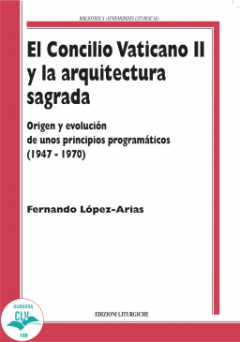The Second Vatican Council on Church Architecture
Recently, a competent Vatican employee said that of the 100 new church buildings in Rome from the last decades that he knew of, only one was liturgically and artistically acceptable. Almost always, however, the architects were given free rein to create buildings according to their taste and "in the spirit of the Council". Of course, this is not how it should be. All the more important is a Spanish study by the Roman liturgy professor Fernando López-Arias, who corrects some misconceptions about the Council and brings it back down to earth with verifiable facts.
He succeeds in this especially through archival studies that have been neglected so far. He relies on council records and on the private archives of people who were directly involved with the drafting of the text. Central, for example, is the archive of Carlo Braga. This enables López-Arias to reconstruct precisely the development of the Council texts and, on this basis, to determine what was really meant by the concise texts. He compiles the whole thing verifiably in synopses.
He goes through the texts of the Council and the preparatory drafts on all the essential elements of a church building: Sedilia, altar, ambo, baptistery, tabernacle, presbytery, choir, organ, etc. One of the strengths of the study is that it takes into account modern church construction up to the Council, which corresponds quite closely to the Council's intentions. This concerns, for example, the free-standing altar with fundamental retention of the "easting" (as in Lutheran contemporary church building), the centrality of the tabernacle, the church as a place of worship and the emphasis on the baptismal room.
It is also important to point out that in order to understand the Council, it is by no means only the articles on church building in the Constitution on the Liturgy (124, 128) that need to be taken into account, but also a long section in the Decree on Priests (5), in which the church is referred to by the term domus orationis - "house of prayer" (wrongly translated as "house of God" in the usual German translation of the Council) - used by Jesus himself. From the point of view of the Council Fathers, this brings into view not only the criterion of liturgical functionality and the active participation of the faithful, but also another traditional criterion of church construction: A church space must also do justice to its extra-eucharistic significance as a place of (communal or individual) worship, meditation, confession, etc.
The book is, as the title suggests, about "sacred architecture" in the Second Vatican Council. On the whole, however, one can say that "sacrality" is no longer a relevant category for most modern church buildings. At best, one speaks unspecifically of spirituality, transcendence or the like. To his great astonishment, López-Arias also knows how to name all kinds of things (participation, functionality, archaeologism ...) among the programmatic principles during the preparation of the Council, but not sacrality. One may speculate: Did people in the 1950s and 1960s (still) assume that sacrality is simply established with the act of consecration, no matter how pretty or ugly a church space opens up?
- Details
- Written by: Stefan Heid
- Category: Recommended reading
 Römisches Institut der Görres-Gesellschaft
Römisches Institut der Görres-Gesellschaft







